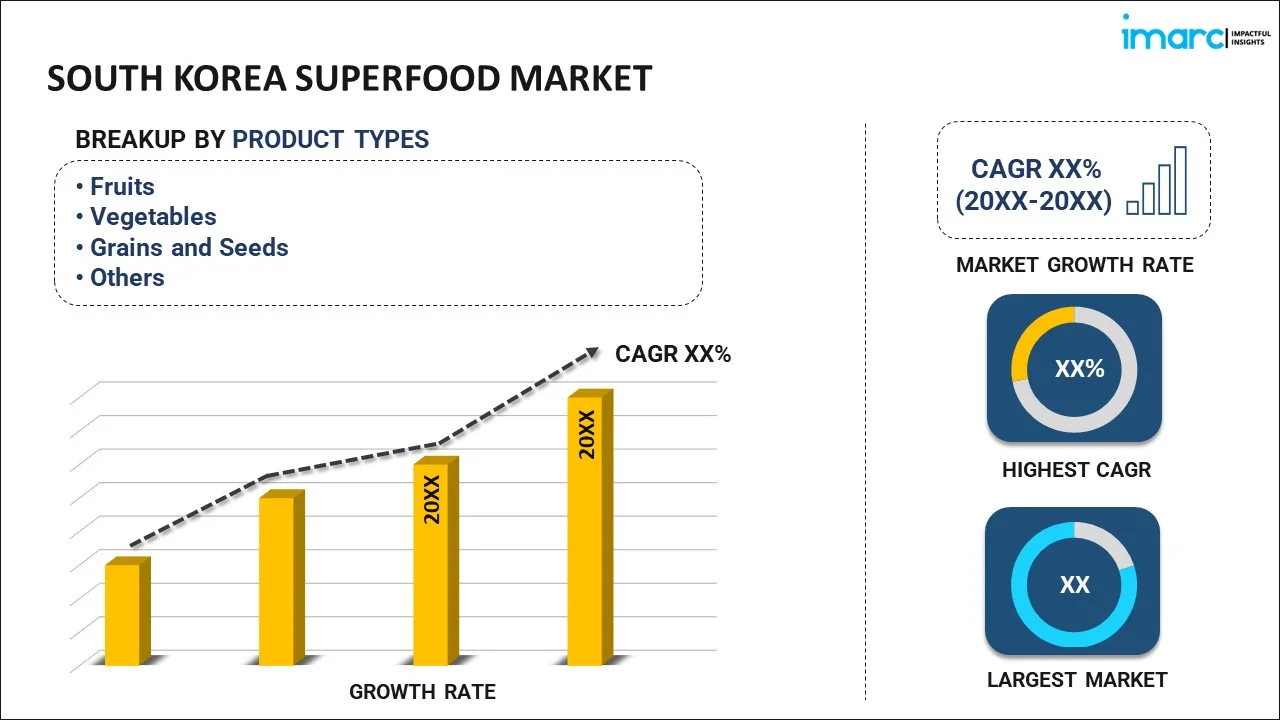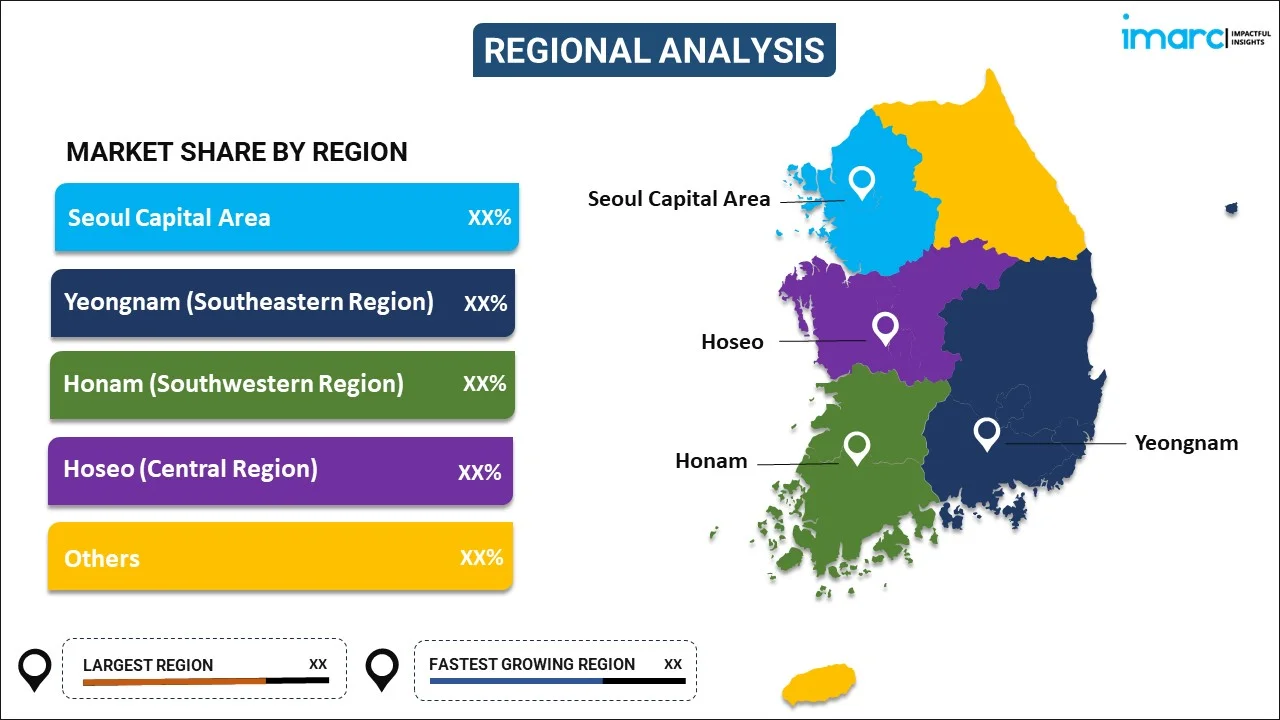
South Korea Superfood Market Report by Product Type (Fruits, Vegetables, Grains and Seeds, Herbs and Roots, Meat, and Others), Application (Bakery And Confectionery, Beverages, Supplements, Convenience/Ready-To-Eat Foods, and Others), Distribution Channel (Supermarkets and Hypermarkets, Convenience Stores, Specialty Stores, Independent Small Grocery Stores, Online Sales, and Others), and Region 2025-2033
Market Overview:
South Korea superfood market size is projected to exhibit a growth rate (CAGR) of 4.85% during 2025-2033. The increasing consumer awareness of the health benefits associated with superfoods, including their high nutritional content and potential disease-fighting properties, is driving the market.
|
Report Attribute
|
Key Statistics
|
|---|---|
|
Base Year
|
2024 |
|
Forecast Years
|
2025-2033 |
|
Historical Years
|
2019-2024
|
| Market Growth Rate (2025-2033) | 4.85% |
Superfoods are nutrient-rich foods that are considered exceptionally beneficial for health and well-being due to their high concentrations of vitamins, minerals, antioxidants, and other essential nutrients. These foods are believed to contribute significantly to overall health, immunity, and longevity. Examples of superfoods include berries, leafy greens, nuts, seeds, and fatty fish. They are often praised for their potential to reduce the risk of chronic diseases, boost energy levels, and support various bodily functions. While the term superfood is not officially defined or regulated, it is commonly used in marketing and popular media to highlight the nutritional prowess of certain foods. It's important to note that a balanced and varied diet, along with a healthy lifestyle, remains key to optimal health, and no single food can provide all the necessary nutrients for well-rounded nutrition.
South Korea Superfood Market Trends:
The burgeoning superfood market in South Korea is propelled by a confluence of factors that underscore a regional shift towards health-conscious consumption. Primarily, the escalating awareness of the correlation between diet and well-being has ignited a widespread demand for nutrient-dense options. Moreover, the increasing prevalence of lifestyle-related ailments has prompted consumers to gravitate towards superfoods renowned for their purported health benefits. As a result, there has been a notable surge in the popularity of kale, chia seeds, and quinoa, among other superfoods, as individuals seek to fortify their diets with essential vitamins and antioxidants. Furthermore, the advent of social media has played a pivotal role in disseminating information about superfoods fostering a culture of wellness and nutrition. Celebrities and influencers often endorse these nutritional powerhouses, amplifying their popularity and driving consumer interest. Simultaneously, the growing inclination towards sustainable and organic practices, as consumers increasingly prioritize products that align with their eco-conscious values, is expected to drive the superfood market in South Korea in the coming years.
South Korea Superfood Market Segmentation:
IMARC Group provides an analysis of the key trends in each segment of the market, along with forecasts at the country level for 2025-2033. Our report has categorized the market based on product type, application, and distribution channel.
Product Type Insights:

- Fruits
- Vegetables
- Grains and Seeds
- Herbs and Roots
- Meat
- Others
The report has provided a detailed breakup and analysis of the market based on the product type. This includes fruits, vegetables, grains and seeds, herbs and roots, meat, and others.
Application Insights:
- Bakery and Confectionery
- Beverages
- Supplements
- Convenience/Ready-to-Eat Foods
- Others
A detailed breakup and analysis of the market based on the application have also been provided in the report. This includes bakery and confectionery, beverages, supplements, convenience/ready-to-eat foods, and others.
Distribution Channel Insights:
- Supermarkets and Hypermarkets
- Convenience Stores
- Specialty Stores
- Independent Small Grocery Stores
- Online Sales
- Others
The report has provided a detailed breakup and analysis of the market based on the distribution channel. This includes supermarkets and hypermarkets, convenience stores, specialty stores, independent small grocery stores, online sales, and others.
Regional Insights:

- Seoul Capital Area
- Yeongnam (Southeastern Region)
- Honam (Southwestern Region)
- Hoseo (Central Region)
- Others
The report has also provided a comprehensive analysis of all the major regional markets, which include Seoul Capital Area, Yeongnam (Southeastern Region), Honam (Southwestern Region), Hoseo (Central Region), and Others.
Competitive Landscape:
The market research report has also provided a comprehensive analysis of the competitive landscape. Competitive analysis such as market structure, key player positioning, top winning strategies, competitive dashboard, and company evaluation quadrant has been covered in the report. Also, detailed profiles of all major companies have been provided.
South Korea Superfood Market Report Coverage:
| Report Features | Details |
|---|---|
| Base Year of the Analysis | 2024 |
| Historical Period | 2019-2024 |
| Forecast Period | 2025-2033 |
| Units | Billion USD |
| Scope of the Report | Exploration of Historical and Forecast Trends, Industry Catalysts and Challenges, Segment-Wise Historical and Predictive Market Assessment:
|
| Product Types Covered | Fruits, Vegetables, Grains and Seeds, Herbs and Roots, Meat, Others |
| Applications Covered | Bakery And Confectionery, Beverages, Supplements, Convenience/Ready-To-Eat Foods, Others |
| Distribution Channels Covered | Supermarkets and Hypermarkets, Convenience Stores, Specialty Stores, Independent Small Grocery Stores, Online Sales, Others |
| Regions Covered | Seoul Capital Area, Yeongnam (Southeastern Region), Honam (Southwestern Region), Hoseo (Central Region), Others |
| Customization Scope | 10% Free Customization |
| Post-Sale Analyst Support | 10-12 Weeks |
| Delivery Format | PDF and Excel through Email (We can also provide the editable version of the report in PPT/Word format on special request) |
Key Questions Answered in This Report:
- How has the South Korea superfood market performed so far and how will it perform in the coming years?
- What has been the impact of COVID-19 on the South Korea superfood market?
- What is the breakup of the South Korea superfood market on the basis of product type?
- What is the breakup of the South Korea superfood market on the basis of application?
- What is the breakup of the South Korea superfood market on the basis of distribution channel?
- What are the various stages in the value chain of the South Korea superfood market?
- What are the key driving factors and challenges in the South Korea superfood?
- What is the structure of the South Korea superfood market and who are the key players?
- What is the degree of competition in the South Korea superfood market?
Key Benefits for Stakeholders:
- IMARC’s industry report offers a comprehensive quantitative analysis of various market segments, historical and current market trends, market forecasts, and dynamics of the South Korea superfood market from 2019-2033.
- The research report provides the latest information on the market drivers, challenges, and opportunities in the South Korea superfood market.
- Porter's five forces analysis assist stakeholders in assessing the impact of new entrants, competitive rivalry, supplier power, buyer power, and the threat of substitution. It helps stakeholders to analyze the level of competition within the South Korea superfood industry and its attractiveness.
- Competitive landscape allows stakeholders to understand their competitive environment and provides an insight into the current positions of key players in the market.
Need more help?
- Speak to our experienced analysts for insights on the current market scenarios.
- Include additional segments and countries to customize the report as per your requirement.
- Gain an unparalleled competitive advantage in your domain by understanding how to utilize the report and positively impacting your operations and revenue.
- For further assistance, please connect with our analysts.
 Inquire Before Buying
Inquire Before Buying
 Speak to an Analyst
Speak to an Analyst
 Request Brochure
Request Brochure
 Request Customization
Request Customization




.webp)




.webp)












